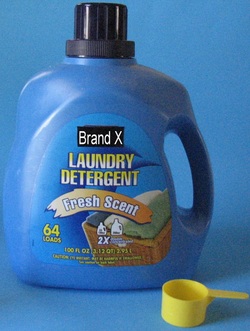
First, we have to consider the use of laundry detergent from a manufacturing and marketing point of view. Along with advertising, this is how we find ourselves consuming a great excess of these products. The desire for the makers and sellers is to move as much product as possible and to do that, we have to believe what we are instructed to do when it is laundry time. If you look at my brand X container, it states that there are 64 loads contained in this product of 100 ounces. The instructions state that for large loads, use the second line inside the cap. And for small loads, use the first line. The second line is almost to the top of the cap and is about 4 ounces. The first line is about 2.5 ounces. But if we divide 100 ounces by 64 loads, we get 1.56 ounces! This really is the new math. So, lets look at what a laundry detergent is an how it works.
A detergent is a surfactant, or "surface active agent". It is a chemical, usually an alkylbenzenesulfonate, and is designed to reduce surface tension and make water "wetter". It is a chemical that has molecules that have a head and a tail. One end likes water, and the other end likes oils and non-water soluble materials. Together the head and tail attach to solids and water and make everything water soluble. But, with current technology they are most efficient when use sparingly. Somehow, we have become used to the idea that a lot of suds mean better cleaning. Actually, the more suds or foam really means that there is more detergent to remove with rinse water. And that is simply a waste of water and makes the washer work harder.
The next time that you do a load of wash, take a washcloth out of the dryer when finished and put it in a warm dish of water. If the water remains clean, you have not used too much detergent. If there is cloudiness, it means that all of the detergent has not been removed and you are using too much. But, there is a little more to this puzzle. While theoretically you can wash clothes without detergent, there is some reason to use a small amount. Some water is "hard" meaning that it contains small amounts of salts like calcium and magnesium. A detergent can trap and remove these salts but it does not take very much.
Here is what I discovered with my experiments. If I use the yellow measuring cup in the photo, (30 ml) or 1 ounce, there was a very low suds level, clean clothes, and no residue. This is for a large load and means that I will get 100 loads! You can't beat this with a stick in the river!
Here is a light-hearted link about an experiment with using no detergent at all...
 RSS Feed
RSS Feed
